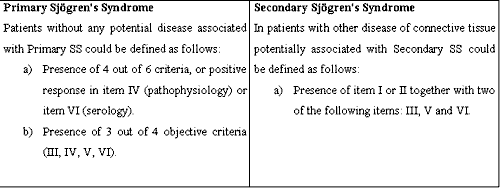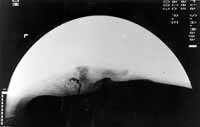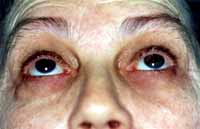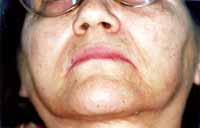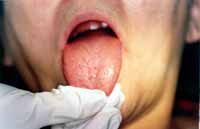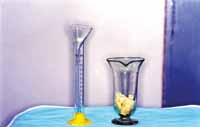

Year: 2004 Vol. 70 Ed. 2 - (22º)
Relato de Caso
Pages: 283 to 288
Sjögren's syndrome: literature review and clinical case management
Author(s):
Tarsila M. C. Freitas 1,
Ana Miryam C. Medeiros 2,
Patrícia T. Oliveira 3,
Kenio Costa Lima 4
Keywords: Sjögren's syndrome, xerostomia, autoimmunity, saliva
Abstract:
Sjögren's syndrome is an autoimmune systemic inflammatory disease characterized by progressive lymphocytic infiltration of several exocrine and non-exocrine organs. It affects primarily the lachrymal and salivary glands causing structural damage and secretory dysfunction of the organs. The production of autoantibodies and polyclonal hypergammaglobuinemia indicate that abnormalities of humoral immunity play a significant role in this pathogenesis and its diagnosis is based upon a combination of several clinical and laboratory findings. The purpose of this report is to present one clinical case of Sjögen's syndrome emphasizing its clinical importance and necessity of the earlier diagnosis to improve the patient's quality of life.
![]()
INTRODUCTION
Sjögren's syndrome is a systemic inflammatory autoimmune disorder that affects salivary and lachrymal glands causing symptoms of xerostomia and dry keratoconjunctivitis. This condition may occur in the absence of connective tissue disorders (Primary Sjögren's Syndrome) or associated with such disorders (Secondary Sjögren's Syndrome). The objective of this paper is to present a case report of Sjögren's Syndrome emphasizing its clinical importance and the need for early diagnosis as an attempt of improving the quality of life of affected patients.
REVIEW OF LITERATURE
Saliva plays a key role in protecting oral tissues against physical, chemical and microbial agents. It also facilitates functions such as gustation, phonation, mastication, deglutition and digestion. The reduction of salivary flow generally manifests itself as dry mouth sensation, as can be observed in patients under radiation therapy to treat malignancies located in the head and neck, in elderly patients and in those using hyposalivatory-inducing drugs, or still as symptoms of systemic diseases including primary biliary cirrhosis, graft versus-host reaction, HIV and autoimmune diseases, specially Sjögren's Syndrome.1,2.
Sjögren's is a chronic systemic inflammatory connective tissue disorder with autoimmune nature characterized by focal progressive lymphocyte infiltration of several exocrine and non-exocrine organs, particularly affecting salivary and lachrymal glands causing structural damage and secretory dysfunction of these organs 3-5. Sjögren's disease is one of the most prevalent rheumatoid disorders, striking as many as one million Americans, affecting all ethnic and racial groups, but mainly women in the 4th and 5th decades of life 1,6.
Although the factors that regulate autoimmune response and determine the differentiation of auto-reactive lymphocytes in autoantibodies are unknown the production of the latter and the hypergammaglobulinemia present in Sjögren's Syndrome indicate that abnormalities in humoral immune response perform a key role in the pathogenesis of this disease. There is also strong evidence of genetic influence since parents of affected patients have increased predisposal for other autoimmune diseases and have specific histocompatibility antigen (HLA) complexes. Infectious etiology probably caused by retroviruses and Epstein-Barr virus has also been reported 3,7,8.
Two forms of Sjögren's Syndrome have been described in the literature - primary and secondary, based on the Classification Criteria of EC (European Community) (Tables 1 and 2) 1,6,9. Sjögren's Syndrome is primary if it involves only salivary and lachrymal glands, and secondary if it affects one or both exocrine organs in association with other connective tissue diseases, such as systemic lupus erythematosus, primary biliary cirrhosis, systemic sclerosis and, most commonly, rheumatoid arthritis 1,6,9.
Clinical findings of Sjögren's Syndrome generally include eye and mouth, involving nasal and vaginal mucosa, as well as fatigue, lymph node adenopathy, primary biliary cirrhosis, interstitial nephritis, pulmonary fibrosis, peripheral vasculitis and neuropathies. Eye and oral symptoms, however, are always present and are the most relevant ones in diagnosing this condition 6,7.
Dry keratoconjunctivitis or xerophthalmia represented by decreased tear production and loss of eye lubrication makes the patient feel like he/she has sand inside the eyes, and in more severe cases, it creates a crust on the periocular region. Vision may become blurred and sometimes patients feel continuous pain. These symptoms are more intense in the morning during awakening, and become more pronounced during the day1,7.
The most evident symptom of Sjögren's Syndrome is xerostomia. Frequently, patients feel dry lips, tongue and pharynx and, consequently, the painful and itching feeling of mucosa make it more difficult to speak, masticate, swallow and digest food. Intra-oral examination normally reveals the presence of viscous and foaming saliva and tongue may be chapped and depapillated 1,6,7. Oral mucosa is reddish and atrophic and there is a prevalence of oral candidiasis, particularly in erythematosus form involving the palate and lip commissure 9,11. Decreased salivary flow and absence of self-cleaning function predisposes individuals to increased risk of dental cavity, especially in the cervical region of the tooth, and periodontal disease. Approximately one third to half of the patients has enlarged parotid gland generally symmetric and recurrent8.
Therefore, the diagnosis of Sjögren's Syndrome is determined by associations of clinical findings, detailed patient's history and laboratory data. Laboratory tests include lip and salivary gland biopsy, and evaluation of blood levels of autoantibodies are also recommended. One or more focus of periductal lymphocytes (50 lymphocytes/ 4mm2) in pathophysiological exam should be evidenced with the presence of autoantibody such as ANA, rheumatoid factor or specific Sjögren's Syndrome antibodies A (SSA) and specific Sjögren's Syndrome antibodies B (SSB) in the blood of the patient. Tests such as parotid sialography and sialometry, Shirmer's test and Rose Bengal and Lissamine Green are indicated to evaluate salivary and lachrymal gland dysfunction 1,6,7.
In terms of differential diagnosis, patients undergoing radiation to treat malignancies in head and neck, elderly patients and those using hyposalivary drugs, as well as individuals with mouth itching may have dry mouth symptoms, however, Sjögren's Syndrome involves a variety of clinical and laboratory signs and is characterized as a systemic disorder1,2.
The treatment of Sjögren's Syndrome is based on the symptoms. Dry eyes are treated with artificial tears and wearing of closed glasses as an attempt to preserve lachrymal pellicle and prevent evaporation. Hyposalivation may be helped by using artificial saliva or sialagogue drugs or sugar-free chewing gum to stimulate saliva production. Topical use of fluoride and stringent oral hygiene control are fundamental to prevent cavities and periodontal disease prevalent in these patients. 12,13.
CLINICAL CASE PRESENTATION
Patient M.S.A.M., female, 63 years old, leukoderma, came to Stomatology Clinic of the Post-Graduate Program, School of Dental Sciences, UFRN, complaining of "itching mouth and gum bleeding". Patient's clinical records had history of rheumatoid arthritis and Sjörgen's Syndrome diagnosed eight years before and followed by symptoms such as dry and burning mouth, difficulties of mastication, speech and food deglutition, dry and itching eyes and dry vagina. The patient also had arthritis and osteoporosis, but did not present diabetes or high blood pressure.
The first diagnosis had been based on medical records, clinical findings and laboratory tests to detect autoantibodies such as rheumatoid factor, ANA, and Anti-SSA, which were positive, and parotid sialography showed evidences of punctiform sialectasias (Figure 1). Thus, patient was under therapy that included the use of artificial saliva and tears and vaginal lubricant, in addition to steroid drugs to treat rheumatoid arthritis.
Next, clinical examination and sialometry were carried out to confirm salivary dysfunction. Extra-oral physical examination evidenced dryness involving face, eyes and lips and irritation of lip commissure compatible with candidiasis erythematosus (Figures 2 and 3). Clinical intra-oral examination showed candidiasis erythematosus in the palate mucosa, periodontal disease represented by bleeding of gums, loss of clinical insertion and dental bulging in addition to dryness of all mouth mucosa and chapped and depapillated tongue surface (Figures 4 and 5). The function of salivary gland was evaluated through sialometry using the technique of saliva stimulation with gum base that showed absence of salivary secretion (Figure 6).
The diagnosis of secondary Sjögren's Syndrome was found based on clinical findings and tests advocated by the European Community, since the patient already had rheumatoid arthritis and was positive for evaluated items I, II, V and VI (Tables 1 and 2). Specific therapy for Sjögren's was kept with the addition of antifungal drugs to treat oral candidiasis and guidelines of oral hygiene and specialized periodontal treatment.
DISCUSSION
Sjögren's Syndrome is a chronic autoimmune systemic disorder affecting primarily salivary and lachrymal glands causing xerostomia (dry mouth) and xerophthalmia (dry eyes). The effects in the eyes are usually known as dry keratoconjunctivitis and clinical symptoms of xerostomia and xerophthalmia are also called dry syndrome. Sjögren's syndrome may have two forms - primary involving only dry syndrome, and secondary in which the patient has the syndrome associated with other autoimmune diseases 7. The latter is a more rare clinical presentation of Sjögren's syndrome that was confirmed by the findings of Simmon, Al-Hashimi, Haghighat2, which found only 5 patients out of 62 cases with the secondary form of the disease (8%).
The current case presented corresponds to a patient with secondary Sjögren's Syndrome based on EC criteria, with signs and symptoms of dry syndrome associated with rheumatoid arthritis considered by Mandel, Surattanont6 as the most common autoimmune disease associated with Sjögren's Syndrome. The patient was female and had her diagnostic confirmed at the age of 55, confirming the findings of Fox et al.1 that showed higher prevalence of the disease in women in 4th and 5th decades of life, affecting all ethnical and racial groups.
Clinical examination of the patient allowed the identification of eye and oral components of Sjögren's Syndrome, in addition to the involvement of skin and vaginal mucosa reported in the literature 6-9. According to Abraham, Al-Hashimi, Haghighat11, the increase of the amount of Candida albicans in the microbiota of patients affected with Sjögren's Syndrome is directly related with the decreased salivary flow triggered by gland dysfunction, characteristic of this syndrome. Saliva contains important antimicrobial agents including immunoglobulin A, lactoferrin, lisozime and lactoperoxidase, and antifungal such as histidines that play a key role in defending the host and protecting against Candida1. In this specific case, the Candida albicans infection was manifested by the presence of erythematosus lesion in the palate and lip commissure, confirming the findings of Rhodus et al.14, which in a study of 20 patients with Sjögren's Syndrome found erythematosus lesion as one of the most common symptoms of oral candidiasis followed by angular cheilitis.
High prevalence of cavities, especially in the cervical region of the teeth and periodontal disease in patients with Sjögren's Syndrome, has already been reported in literature 2,7,12. In this case the patient had a large number of restored and lost teeth, but did not have any cavity. On the other hand, her periodontal status was characterized by presence of periodontitis associated with chronic gingivitis, contrasting with decreased biofilm buildup on the cervical region of teeth, confirming the assumptions by Najera et al.12 that in a study carried out in 25 patients with Sjögren's Syndrome found high predisposition for the development of periodontal disease and loss of alveolar bone in patients with rheumatoid arthritis.
In addition to conventional symptoms, Sjögren's Syndrome should investigate positive findings through several methods including patient's history, blood protein tests, sialochimetry and sialometry, lip gland biopsy and sialography 15. The image of the salivary gland may be acquired through several procedures besides sialography, namely Magnetic resonance imaging, Computed Tomography scan, Ultrasound and Scintigraphy. According to Kalk et al.4, although sialography is one of the oldest imaging procedures, it is still the method of choice to explore ductal system of parotid gland since it is less expensive and more accessible to patients. Mandel, Orchowski15 recommend the use of ultrasound, a simple and non-invasive method for patients allergic to iodine-based contrasts or with acute infection in which the use of sialography is not indicated.
In this case the method used to visualize the parotid ductal system was sialography, and the image revealed presence of punctiform sialectasia, main duct of anatomic aspect, which is sought as one of the most common findings in sialograms of patients with Sjögren's Syndrome, when compared against the other patterns of sialectasia such as globular, cavitary and destructive 2,4,15. The function of the salivary gland was evaluated through sialometry, using the technique of salivation stimulated with gum base, but other mastication and gustative methods are also mentioned in the literature, such as the use of pre-pressed cotton balls, Carlson-Crittenden modified cup and the use of lemon juice 1,5,9.
In general, the treatment of patients with Sjögren's Syndrome is carried out by the rheumatologist. The therapy for the dry syndrome is palliative, to mitigate mouth and eye symptoms and to improve the quality of life of patients7,13. In this specific case, the patient was using artificial saliva and tears and vaginal cream, but the dry syndrome condition complicated by oral candidiasis was present, demonstrating the need for patients' collaboration and prolonged follow-up by the multidisciplinary team including rheumatologist, ENT doctors, dentists and psychologists since the morbidity triggered by the disease has caused depression in many patients. It is important to point out that these patients have increased risk of developing lymphoreticulary malignancies such as lymphoma (mainly B cells non-Hodgkin's) and sarcoma of reticular cells and macroglobulinemia of Waldenstrom 7,8.
CLOSING REMARKS
Sjögren's Syndrome is a systemic chronic disease that results in several systemic signs and symptoms in affected individuals, requiring stringent follow-up and monitoring carried out by a multidisciplinary team in order to provide better quality of life for the patients. Xerostomia is considered the major oral symptom and clinical sign of the disease; therefore, it enhances the importance of early diagnosis and treatment made by otorhinolaryngologists, rheumatologists and dental surgeons that should be capable of recognizing this entity in clinical practice.Tables
Table 1. Classification Criteria of the European Community for Sjögren's Syndrome (2002).
Classifying Criteria of Sjögren's Syndrome
I. Eye symptoms: Patients should present one affirmative response for at least one of the following questions:
1.Have you been presenting daily dry eye issues over the last three months?
2.Do you have recurrent sensation of having sand in your eyes?
3.Do you use artificial tears more than 3 times a day?
II. Mouth symptoms: Patients should present one affirmative response for at least one of the following questions:
1.Have you been feeling dry mouth everyday over the last three months?
2.Have you been presenting persistent edema in salivary glands?
3.Do you drink fluids very often to improve deglutition of dry foods?
III. Eye signs: Eye involvement detected by at least one in two of the following tests:
1.Shirmer test performed without anesthesia ( 5mm/ 5 min).
2.Rose Bengal Score or other score to measure eye dryness ( 4, according to Van Bysterveld Score System)
IV. Pathophysiology: Presence of focal lymphocytic sialoadenitis detected by skilled pathologist (one or more focuses of periductal lymphocytes -50 lymphocytes/ 4mm2)
V. Involvement of salivary gland detected through one of the following diagnostic methods:
1.Total absence of salivary flow stimulation ( 1.5 ml/ 15 minutes)
2.Parotid Sialography showing the presence of diffuse sialectasias (punctiform, cavitary or destructive pattern) with no evidence of main duct obstruction.
3.Salivary Scintigraphy showing low absorption, decreased concentration and/or low excretion of radioactive isotope).
VI. Autoantibodies: presence in the blood of the following autoantibodies (ANA):
1. Anti-SSA, anti-SSB antigen antibodies or both.
Source: 15.
Table 2. Criteria established by European Community to classify Primary and Secondary Sjögren's Syndrome (2002).
Source: 15.
Figure 1: Parotid Sialogram with punctiform sialectasias.
Figure 2: Clinical aspect of eye dryness compatible with dry keratoconjunctivitis.
Figure 3: Clinical aspect of lip commissure irritation compatible with candidiasis erythematosus.
Figure 4: Dry lip mucosa.
Figure 5: Atrophic and chapped. Lingual surface.
Figure 6: Sialometry showing absence of salivary secretion.
REFERENCES
1. Fox PC et al. Sjögren's syndrome: A model for dental care in the 21st century. JADA 1998; 129: 719-27.
2. Simmons DD, Al-Hashimi I, Haghighat N. Effect of xerostomic medications on stimulated salivary flow rate in patients with Sjögren syndrome. Quintessence Int 2000; 31: 196-200.
3. Dörner T et al. Immunoglobulin repertoire analysis provides new insights into the immunopathogenesis of Sjögren's syndrome. Autoimmunity Reviews 2002; 1: 119-24.
4. Kalk WI et al. Parotid sialography for diagnosing Sjögren syndrome. Oral Surg Oral Med Oral Pathol Oral Radiol Endod 2002; 94:131-7.
5. Pedersen AM et al. Primary Sjögren syndrome: salivary gland function and clinical oral findings. Oral Dis 1999; 5: 128-38.
6. Mandel LM, Surattanont F. Bilateral parotid swelling: A review. Oral Surg Oral Med Oral Pathol Oral Radiol Endod 2002; 93: 221-37.
7. Neville BW et al. Patologia das glândulas salivares - In: Neville BW et al. Patologia Oral e Maxilofacial. 2ª ed. Rio de Janeiro: Guanabara Koogan; 1998. 314-52.
8. Regezi AJ, Sciubba JJ. Doenças das glândulas salivares In: Regezi AJ, Sciubba JJ. Patologia bucal: Correlações clínicopatológicas. 3ª ed. Rio de Janeiro: Guanabara Koogan; 2000. 195-243.
9. Rhodus NL et al. Quantitative assessment of dysphagia in patients with primary and secondary Sjögren's syndrome. Oral Surg Oral Med Oral Pathol Oral Radiol Endod 1995; 79: 305-10.
10. Vitali C et al. Classification criteria for Sjögren syndrome: a revised version of the European criteria proposed by the American-European Consensus Group. Ann Rheum Dis 2002; 61: 554-8.
11. Abraham CM, Al-Hashimi I, Haghighat N. Evaluation of the oral Candida in patients with Sjögren syndrome. Oral Surg Oral Med Oral Pathol Oral Radiol Endod 1998; 86: 65-8.
12. Najera MP et al. Prevalence of periodontal disease in patients with Sjögren syndrome. Oral Surg Oral Med Oral Pathol Oral Radiol Endod 1997; 83: 453-7.
13. Mariette X. Current and potential treatment for primary Sjögren syndrome Joint Bone Spine 2002; 69: 363-6.
14. Rhodus NL et al. Candida Albicans levels in patients with Sjögren's syndrome before and after long-term use of pilocarpine hydrochloride: A pilot study. Quintessence Int 1998; 29: 705-10.
15. Mandel LM, Orchowski YS. Using ultrassonography to diagnose Sjögren syndrome. JADA 1998; 129:1129-33.
1 Master studies in Oral Pathology under course / UFRN.
2 Ph.D., Professor of the Post-Graduation Program on Oral Pathology / UFRN.
3 Ph.D., Professor of Clinical Stomatology, PUC/RS.
4 Ph.D., Professor of the Post-Graduation Course on Preventive and Social Dental Care / UFRN.
Affiliation: Universidade Federal do Rio Grande do Norte.
Address correspondence to: Tarsila Morais de Carvalho Freitas - Programa de Pós-graduação em Patologia Oral. Av. Salgado Filho, 1787 Lagoa Nova Natal-RN 59056-000.
Tel (55 84) 215-4108/ 215-4138 - Fax: (55 84) 215-4138 - E-mail: taifreitas@ig.com.br.
Study presented at XI Congresso Brasileiro de Estomatologia/ XXIX Jornada Brasileira de Estomatologia, Recife-PE, July 22 - 25, 2003.
